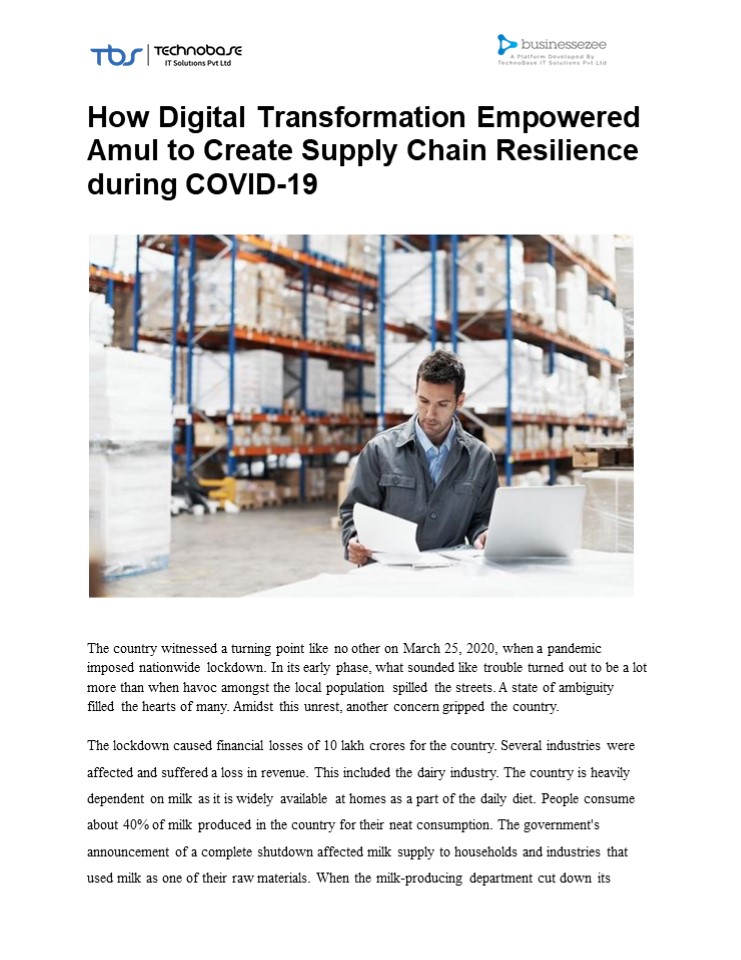Digital transformation (1) - PowerPoint PPT Presentation
Title:
Digital transformation (1)
Description:
TBS combines tech expertise and business intelligence to catalyse change and deliver results. We are committed to providing process transparency and high-quality products to our customers within the confines of their budgets and schedules. – PowerPoint PPT presentation
Number of Views:1
Title: Digital transformation (1)
1
How Digital Transformation Empowered Amul to
Create Supply Chain Resilience during COVID-19
The country witnessed a turning point like no
other on March 25, 2020, when a pandemic imposed
nationwide lockdown. In its early phase, what
sounded like trouble turned out to be a lot more
than when havoc amongst the local population
spilled the streets. A state of ambiguity filled
the hearts of many. Amidst this unrest, another
concern gripped the country. The lockdown caused
financial losses of 10 lakh crores for the
country. Several industries were affected and
suffered a loss in revenue. This included the
dairy industry. The country is heavily dependent
on milk as it is widely available at homes as a
part of the daily diet. People consume about 40
of milk produced in the country for their neat
consumption. The government's announcement of a
complete shutdown affected milk supply to
households and industries that used milk as one
of their raw materials. When the milk-producing
department cut down its
2
production, unable to sell even one unit of milk,
AMUL came up with a perfect solution that
revealed itself as an asset during this time when
the whole nation was in lockdown.
Image source Pinterest You must be wondering,
how it was possible when all hotels and
restaurants were shut down, contributing up to
20-30 of its revenue? There is a very simple
answer to this they made analyzed and
understood the consumer needs. Several marketers
say that consumer behavior is bound to change
after every major crisis. It became obvious that
people couldn't order food from restaurants
because of the shutdown, so they ended up making
food by themselves. Since lockdown was nowhere a
normal thing, so what people started doing is
they started with the lockdown food trend, which
included delicacies like mug cakes, pizzas, and
dalgona coffee, and it's nothing to guess that
milk and milk byproducts are most common in
these. This made a sudden increase in demand for
dairy products, and Amul was the only company
able to meet this demand as it was operating at
100 capacity.
3
To prevent the measures against COVID 19, 80 of
consumers started buying packaged milk instead
of loose milk. This increased cottage cheese
sales by 40, cheese by 80, and condensed milk
by 100. The Economic Transcript has mentioned
With this increase in sales and their existing
products, they dominated the market and launched
33 new products. Amul started collecting 35 lakh
of milk every day to fulfill consumer
demand. The Economic Times has mentioned To
gauge the complexity of Amuls supply chain,
consider this - the co-operative has a total of
- 3.6 million farmers
- 18,700 societies
- 5,000 milk tankers
- 200 chilling stations
- 750 SKUs
- 62 branches
- 10,000 distributors
- 1 million retailers
- Amul used technology to improve its supply chain.
In an industry where supply chain management is
a challenge in itself, Amul has managed to
maintain delivery of dairy products across the
country. The company took advantage of idle
frozen products resources and redeployed them
towards the dairy supply chain. It chose this
strategy because of an imbalance in its original
supply chain.
Digital Transformation through integrated IT
infrastructure Now, after seeing the success of
Amul, the question that arises here is how they
were able to manage their resources well. The
Economic Transcript has also mentioned The
managing director of the largest dairy
cooperative in India, Dr. Rupinder Singh Sodhi,
took a firm decision to invest 80 crores in
4
creating a digital system to track the entire
operation. Since then, Amul was able to identify
that their ice-cream and frozen food division was
idle, so they shifted their resources to other
divisions, which helped Amul operate at 115
capacity.
- A great deal of change was happening within the
organization. Amul had to up its game to remain
relevant in the Indian dairy market. An IT
roadmap was drawn up with three objectives - Enable the supply chain management end-to-end,
from procurement to delivery. - Ensure real-time visibility and decision-making
at each link in the value chain. - Bring all stakeholders together onto a single
platform to provide a 360-degree view of the
business. - The most important aspect of this transformation
has been real-time insights. The system allows
Amul to know when the stock will reach a
particular retail outlet to send the delivery
without any delay. It also gives a breakdown of
what products are doing well in each region to
plan accordingly and keep the supply chain
moving swiftly. - Amul has built a private cloud with a data center
and a disaster recovery system with automatic
backups. The cloud enables the performance of
high-availability applications with reduced
latency, improves service efficiency, and
exceptional management ease for Amul's
5
geographically dispersed teams. Amul was able to
divert idle resources overnight and ensure a
steady supply of dairy products.
Way forward Improvements in every process are a
huge benefit from the Amul digital
transformation. Processes are seamless now and
allow for more efficient operations by improving
data accuracy and integration with the
distributor management system. Automated
applications have also reduced repetitive work
and increased safety.
www.technobase.in
www.businessezee.com































